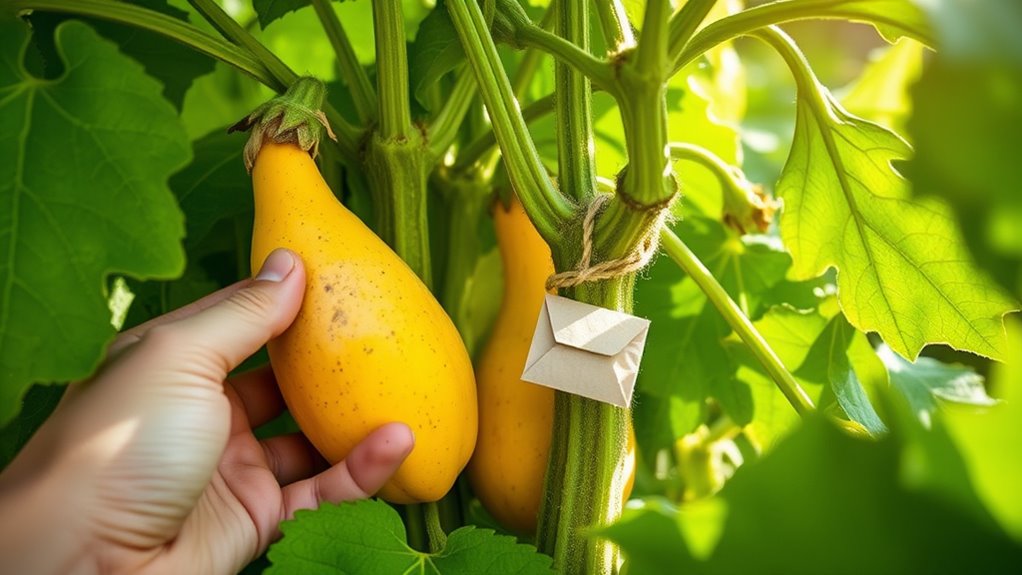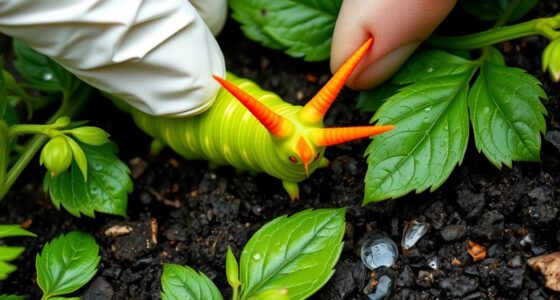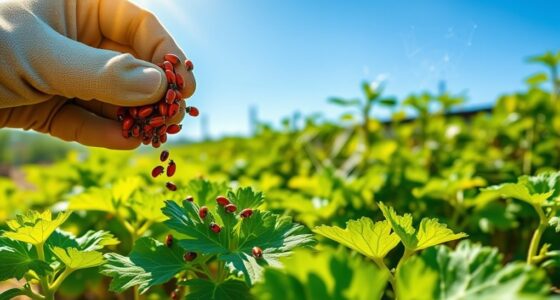To prevent squash vine borer damage, regularly check your plants for signs like wilting or holes near the base. Use physical barriers like fine netting or row covers and plant resistant varieties. Timely planting and crop rotation help disrupt their lifecycle. Attract helpful insects with flowering herbs and consider trap crops to divert pests. Promptly remove infested plants and apply organic controls like neem oil. Continue exploring for more ideas to keep your squash healthy all season.
Key Takeaways
- Implement physical barriers like fine netting or row covers to prevent moths from laying eggs on squash plants.
- Schedule early planting and stagger sowing to avoid peak borer activity periods.
- Regularly inspect plants for entry holes, wilting leaves, or boreholes, and remove infested tissues promptly.
- Use trap crops such as pumpkins or Hubbard squash to divert pests away from main crops.
- Promote natural predators by planting flowering herbs and practicing garden hygiene to reduce pest populations organically.
Recognizing the Signs of Squash Vine Borer Infestation

To effectively combat squash vine borers, you need to recognize their signs early. Look for wilting or yellowing leaves, especially near the base of the plant, which can indicate stem damage. Check the stems closely; boreholes or small holes near the plant’s crown are signs of infestation. You might also notice sawdust-like frass around the entry points. To make your plants less attractive to borers, practice companion planting with herbs like marigolds or radishes, which can deter pests. Improving soil health with proper amendments can strengthen your plants’ resilience. Healthy, vigorous plants are better at resisting borer attacks. Regularly inspecting your squash plants and maintaining soil vitality are key steps in early detection and prevention. Additionally, understanding plant resilience can help you implement effective preventative measures.
Timing Your Planting to Minimize Borer Damage

Timing your planting carefully can considerably reduce squash vine borer damage. To do this, plan your planting schedule so your summer squash matures when borers are least active, typically early to mid-summer. Consider starting seeds indoors early, using seed starting methods, so your plants develop before the peak borer activity period. Adjust your planting schedule based on local climate and pest activity patterns—early planting can help you harvest before borers become a problem. Staggering plantings also spreads out vulnerability, reducing the risk of total crop loss. By aligning your seed starting and planting dates with pest lifecycle timelines, you give your plants a head start and decrease their chances of suffering borer damage during critical growth stages. Monitoring pest activity patterns and adjusting your planting schedule accordingly can further enhance your crop’s resilience.
Using Physical Barriers to Protect Your Vines
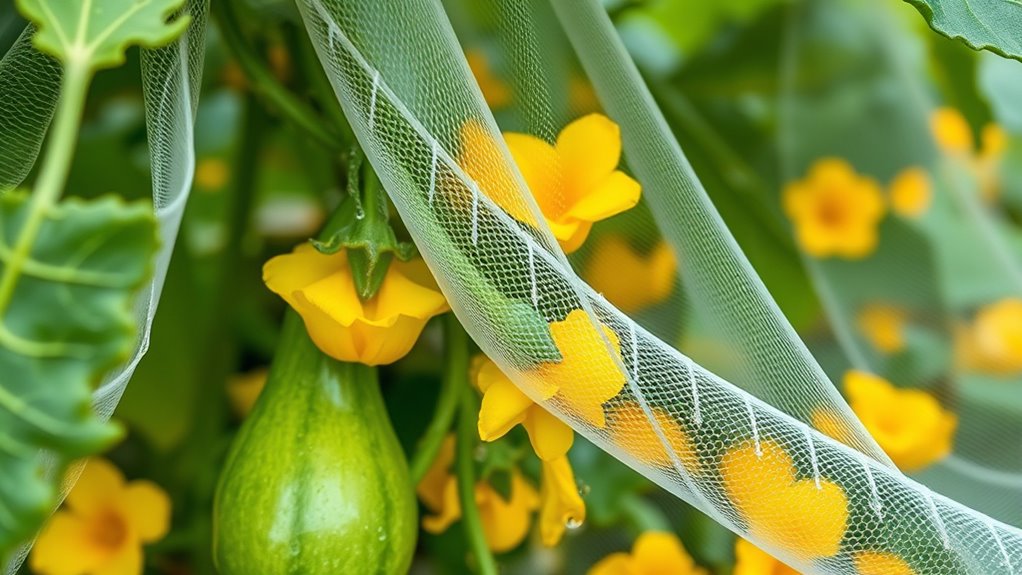
Implementing physical barriers can substantially reduce squash vine borer damage by blocking the moths from laying eggs on your plants. Covering your squash with fine netting or row covers creates a physical shield, preventing adult moths from accessing the vines. Proper plant spacing not only promotes healthy growth but also makes it easier to install and maintain these barriers. Mulching benefits include helping to keep the soil moist and suppress weeds, which can attract pests or create hiding spots for eggs. Guarantee the covers are securely anchored around the plants to prevent moths from sneaking underneath. Regularly check for tears or gaps and repair them promptly. Using these physical barriers, combined with good plant spacing and mulching benefits, offers an effective, chemical-free way to protect your summer squash from vine borer damage. Additionally, understanding the biological lifecycle of the squash vine borer can help time the application of barriers more effectively and increase your chances of success.
Applying Organic and Chemical Controls Effectively
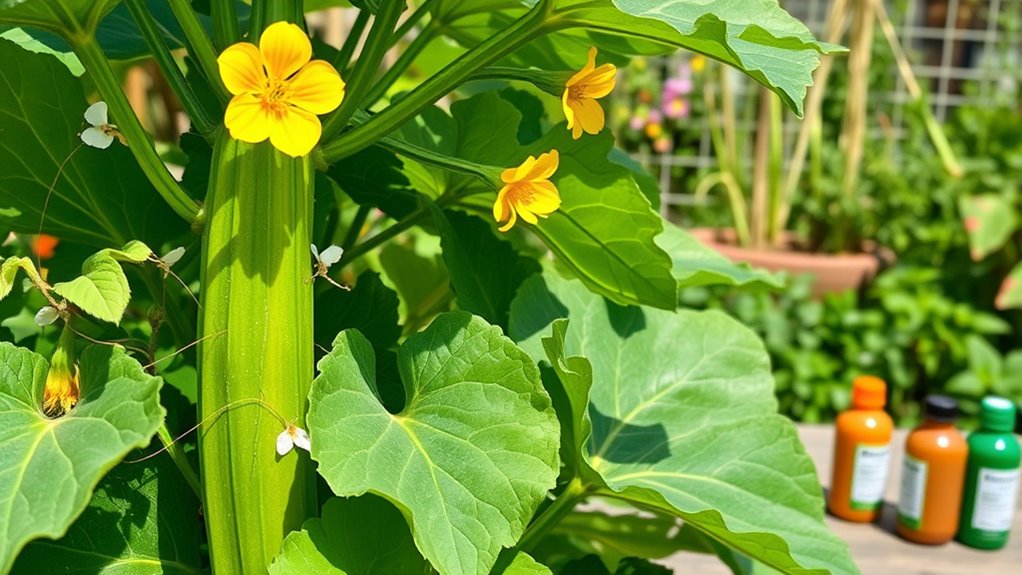
Applying organic and chemical controls effectively requires understanding the specific products and methods suited for squash vine borer management. To maximize success, focus on timely application and proper coverage. Organic sprays like neem oil or spinosad can be applied directly to the vines, targeting larvae and adults. Chemical treatments may include insecticides labeled for borer control, but should be used carefully to avoid harming beneficial insects. Remember to:
- Apply organic sprays at the first sign of adult activity
- Use chemical treatments according to label instructions
- Target the base and stems where borers tend to tunnel
- Reapply after heavy rain or if new damage appears
- Incorporate integrated pest management practices to enhance control efforts
Combining these methods boosts your chances of preventing damage while minimizing pesticide use. Always prioritize safety and follow product guidelines for effective control.
Encouraging Natural Predators to Keep Borsers in Check

Encouraging natural predators is a sustainable way to keep squash vine borers in check. Beneficial insects, like parasitic wasps, prey on the borer larvae, reducing their population naturally. To attract these predators, plant flowering herbs such as dill, fennel, and alyssum around your garden. These plants provide nectar and pollen, which attract predator insects and boost their numbers. Avoid using broad-spectrum pesticides that can kill beneficial insects, and instead, create a habitat that encourages predator activity. You can also provide shelter by leaving some areas undisturbed or adding insect hotels. Creating a balanced ecosystem helps establish a natural balance, decreasing borer damage without relying solely on chemical controls.
Practicing Crop Rotation and Proper Garden Hygiene

Practicing crop rotation and maintaining proper garden hygiene are essential steps in controlling squash vine borer infestations. By rotating squash with non-related crops, you reduce the borer’s habitat and disrupt their lifecycle. Good garden hygiene involves removing plant debris and infested vines to eliminate overwintering sites. Proper compost management ensures you don’t inadvertently harbor pests, so compost plant material thoroughly before use. Applying mulch around your plants helps prevent adults from laying eggs on the soil surface. Additionally, consider these practices:
- Rotate squash with legumes or cereals each season
- Remove and dispose of debris and infested plants promptly
- Use mulch to create a barrier against egg-laying
- Maintain clean tools and containers to prevent pest spread
- Incorporate knowledge about pest management techniques in water parks to better understand environmental control methods
Together, these practices help protect your summer squash from vine borer damage.
Monitoring and Removing Infested Plants Promptly

Monitoring your summer squash plants regularly is key to catching vine borer activity early. Check the stems for small holes or sawdust-like frass, as these indicate infestation. Promptly removing and destroying infested plants or stems helps prevent the pest from spreading. Good compost management also reduces disease and pest issues, supporting plant health and resilience. When applying mulch, ensure it’s not piled against the stems, as this can create a humid environment that encourages pests. Mulch should be kept a few inches away from the plants to improve airflow and reduce hiding spots for vine borers. Consistent monitoring, combined with timely removal of infested plants and proper mulch application, markedly decreases the risk of vine borer damage. Integrated pest management strategies can further enhance your efforts to protect your squash.
Implementing Trap Crops to Distract Pests
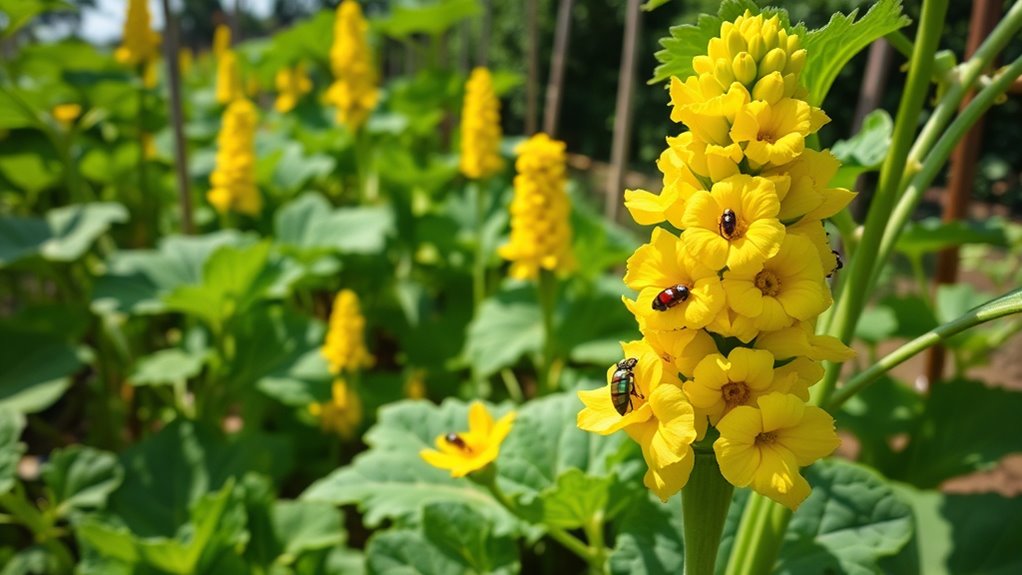
Choosing the right trap crops is key to attracting squash vine borers away from your main plants. You should also focus on placing these crops in strategic locations to maximize their effectiveness. When done correctly, trap crops can substantially reduce pest pressure and protect your summer squash. Incorporating necessary cookies during setup can help monitor and optimize the placement of these crops for better pest management.
Selecting Effective Trap Crops
Selecting effective trap crops is a crucial step in managing squash vine borer damage, as they lure pests away from your main summer squash plants. To maximize benefits, choose plants that attract the vine borer and support beneficial insects. Consider these factors for successful trap crop selection:
- Attractiveness to squash vine borer larvae and adults
- Compatibility with your main crop’s growing conditions
- Ability to host beneficial insects that naturally control pests
- Ease of planting and maintenance
Popular trap crops include Hubbard squash and pumpkins, which draw the borers away effectively. Proper trap crop selection encourages pest diversion and boosts beneficial insect activity, reducing reliance on chemical controls. By choosing the right plants, you create a natural barrier that helps protect your summer squash throughout the season.
Proper Trap Crop Placement
Once you’ve identified effective trap crops, the next step is to place them strategically to maximize their pest-distracting effect. Position trap crops near your main squash plants, but keep some distance to prevent pests from moving directly to your squash. Use companion planting to enhance their effectiveness, pairing trap crops with plants that repel squash vine borers or attract beneficial insects. Mulching techniques are also crucial; apply a layer of mulch around trap crops to suppress weeds and reduce soil vibrations that attract pests. Regularly monitor the trap crops for signs of borer activity, and replace or reinforce them as needed. Proper placement and maintenance help divert pests away from your summer squash, increasing your chances of a healthy, borer-free harvest. Incorporating trap crop placement strategies effectively can significantly improve pest control outcomes.
Selecting Resistant Varieties for Better Defense
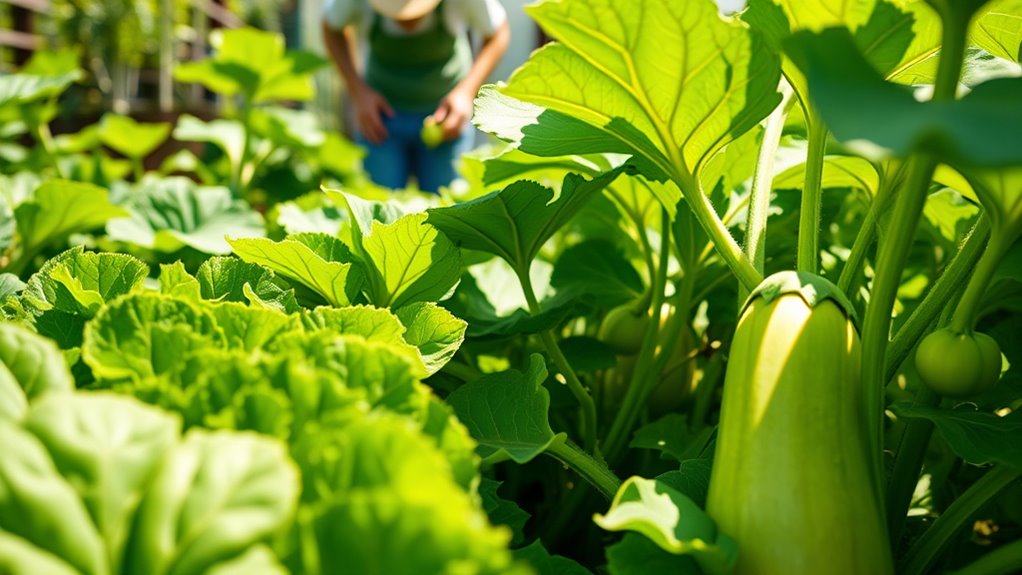
Opting for resistant squash varieties gives you a stronger defense against squash vine borer damage. By focusing on genetic resistance through careful cultivar selection, you can reduce the likelihood of infestation. Resistant cultivars are bred to naturally deter or withstand borer attacks, making them an effective part of your pest management strategy. When choosing varieties, look for those labeled specifically for borer resistance or mention genetic resistance traits. Incorporate proper storage techniques for seeds and plants to ensure their longevity and health.
Maintaining Overall Garden Health to Reduce Vulnerability
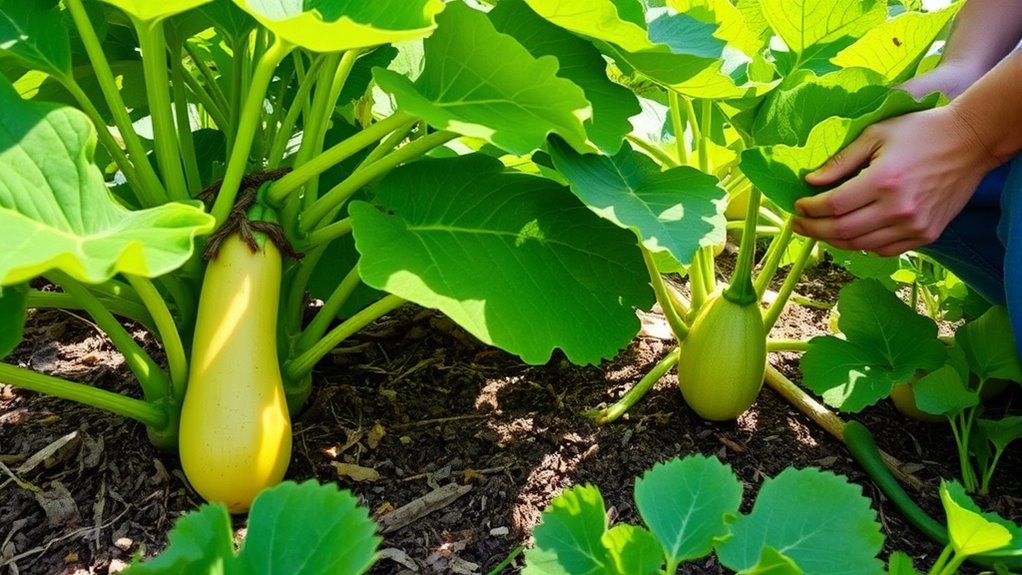
Keeping your soil healthy through proper amendments and crop rotation strengthens your plants and helps resist pests. Choosing pest-resistant varieties adds an extra layer of protection against infestations. When your garden is strong overall, your squash is less likely to fall victim to vine borers.
Healthy Soil Practices
Healthy soil is the foundation of a resilient garden that can better withstand pests like squash vine borer. To boost soil health, incorporate soil amendments such as organic matter or compost to improve fertility and structure. Use composting techniques to create nutrient-rich compost that feeds your plants naturally. Healthy soil promotes strong root systems, making plants less vulnerable to pests. Consider these practices:
- Regularly add compost to enrich soil nutrients
- Rotate crops to prevent soil depletion
- Avoid over-tilling to maintain soil structure
- Test soil pH and adjust with amendments as needed
Pest-Resistant Plant Varieties
Choosing pest-resistant plant varieties is one of the most effective ways to reduce vulnerability to squash vine borer. Selecting resistant cultivars can naturally deter pests and minimize damage. Combine this with practices like companion planting, which can repel borers, and mulch barriers that physically block egg-laying sites. These strategies strengthen your garden’s overall health and resilience. Incorporate plants such as nasturtiums or marigolds nearby to act as natural repellents. Using mulch barriers around your squash creates a protective layer that hinders borer access. Here’s a quick guide:
| Technique | Benefit |
|---|---|
| Resistant varieties | Reduce pest attraction |
| Companion planting | Deters pests naturally |
| Mulch barriers | Blocks egg-laying sites |
| Crop rotation | Prevents pest buildup |
| Healthy soil | Boosts plant defenses |
Frequently Asked Questions
How Can I Differentiate Squash Vine Borer Damage From Other Pests?
To tell squash vine borer damage apart from other pests, look for specific visual damage like wilting or sudden vine collapse. Check for frass presence, which appears as sawdust-like residue near entry holes or inside the stems. Unlike other pests, borers create these holes and frass deep within the stems, so inspecting the base of the plant can help you identify their activity and differentiate it from other common issues.
What Are the Best Times of Day to Check for Borers?
Think of checking your squash as a vigilant guardian watching for invaders. The best times to spot borers are early morning and late afternoon when pests are most active. During these hours, inspect the stems and look for tiny holes or signs of tunneling. By staying attentive at these times, you increase your chances of catching and managing borer damage before it worsens.
Are There Specific Organic Sprays Effective Against Squash Vine Borers?
You can use organic sprays like neem oil or insecticidal soaps to combat squash vine borers. These natural repellents work by disrupting the pests’ life cycle and deterring them from laying eggs. Apply them thoroughly on the stems and undersides of leaves, especially during early morning or late evening. Regular treatments help protect your squash plants without harmful chemicals, keeping pests at bay naturally.
How Do I Identify Natural Predators of Squash Vine Borers?
To identify natural predators of squash vine borers, focus on beneficial insects like tachinid flies, braconid wasps, and parasitic wasps. You can observe predator identification by looking for these insects around your plants, especially near damaged vines. Beneficial insects usually have distinctive appearances—tiny wasps or flies with specific markings. Encouraging these predators helps naturally control borers, so avoid broad-spectrum pesticides that might harm them.
Can Companion Planting Help Prevent Borer Infestations?
Think of your garden as a bustling neighborhood; companion planting acts like a friendly fence, keeping pests at bay. By planting pest repellent plants alongside summer squash, you can create a natural shield that confuses or deters squash vine borers. These companion planting benefits include reducing infestations without chemicals, encouraging beneficial insects, and fostering a healthier garden environment. It’s a simple, effective way to protect your crops with nature’s own defense system.
Conclusion
By staying vigilant and applying these strategies, you can protect your summer squash from squash vine borers. Regular monitoring, physical barriers, and choosing resistant varieties make a big difference. Remember to act quickly if you spot signs of infestation and encourage natural predators. With consistent effort, you’ll enjoy healthy, borer-free vines all season. So, why let these pests ruin your harvest when effective prevention is within your reach?
